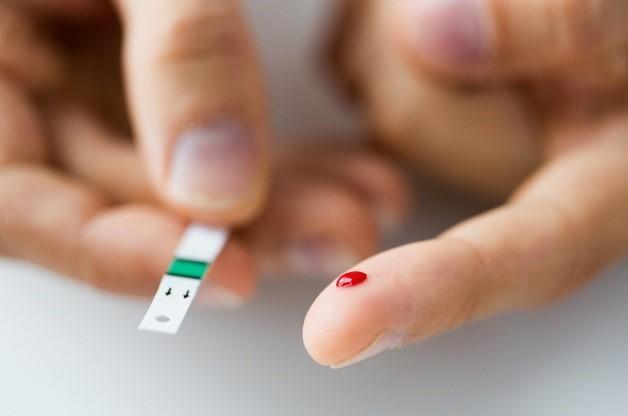Contrary to popular belief, rarely does a person wake up one day and POOF! they suddenly get struck with a disease that comes out of nowhere.
Even though learning that you have a disease can be shocking, trust me, it’s no surprise to your body. Disease is created over time, step by step, as long as you continue to provide the right conditions for it to flourish.
And nowhere is this truer than with Type 2 diabetes.
Here is how Type 2 diabetes is created, how you can recognize it, and how you can help decrease your risk or even turn it around!
The 6 steps to diabetes
There are 6 steps that take you from normal blood sugar levels to Type 2 diabetes. Do you see yourself in any of these steps?
Step 1-Insulin resistance
Our typical diets are inundated with refined carbs which cause a surge of glucose into your bloodstream. Excess glucose in your blood can be dangerous or even deadly, so your pancreas releases insulin to quickly restore a proper blood sugar level.
If this happened only once in a while, there would be no problem. But growing numbers of people are taking in excessive amounts of refined carbs, causing the pancreas to repeatedly secrete insulin.
Eventually your cells start to resemble a soaked sponge—they can’t absorb any more glucose so they turn off their receptors for insulin—known as insulin resistance.
Take a look at yourself. If your 4 food groups are pasta, bread, chips and cookies, you never drink anything that isn’t sweetened, and you’re overweight, chances are excellent you have insulin resistance in the making.
Step 2- Insulin resistance with hyperinsulinism
Once insulin resistance hits, your pancreas gets frustrated because the insulin it produces isn’t as effective anymore.
So what does it do? Releases MORE insulin—and you end up with elevated glucose AND insulin in your bloodstream!
High levels of insulin in your blood increases your risk of:
- High triglycerides
- High uric acid levels
- Atherosclerosis
- Obesity
- Hypertension
At this stage your blood sugar level starts resembling a roller coaster—spikes followed by drops.
If you’ve had a long-standing love affair with refined carbs and get jittery when you haven’t eaten for a while, insulin resistance with hyperinsulinism may be brewing.
Step 3-Insulin resistance, hyperinsulinism and low blood sugar
As time goes on and your blood levels of insulin and glucose are consistently high, your blood sugar roller coaster becomes more dramatic.
Your pancreas takes longer to produce insulin after you eat and your blood sugar level skyrockets. Then eventually the pancreas kicks in, which then causes your blood sugar to plummet.
This is called reactive hypoglycemia and if you’re noticing any of these symptoms, it may be a concern for you:
- Weight gain
- Sugar cravings
- Frequent hunger
- Difficulty concentrating
- Feeling anxious or panicky
- Lacking focus or motivation
- Fatigue
Step 4- Prediabetes
Eventually your blood sugar level will peak above the normal range and you will arrive in the land of prediabetes.
What you start seeing is a combination of sleepiness after a carbohydrate meal, along with the symptoms of hypoglycemia I mentioned above.
Step 5- Type 2 diabetes with insulin resistance and high insulin production
In this stage your blood sugar level becomes more frequently elevated.
Your pancreas is still cranking out insulin, but it’s getting pooped and is slower and slower about it. This results in dangerously high glucose levels after eating.
Step 6- Type 2 diabetes with little or no insulin production
Now your pancreas is exhausted—its beta cells become dysfunctional and can no longer produce adequate insulin or any at all.
Your blood sugar levels are more consistently high for longer periods of time—even after fasting.
The symptoms you see here are:
- Increased thirst
- Increased hunger
- Frequent urination
- Weight gain
- Blurred vision
Change your path now!
No matter what step of Type 2 diabetes you may have reached, the condition is very preventable, and even if you have gone through all six steps, there is a LOT you can do to help keep it under control and even turn it around!
1- Eat for diabetes prevention and control
Here are some good food choices to combat diabetes:
- Salmon and cod: The Omega-3 essential fatty acids in fish like salmon and cod provide crucial support to your metabolism including maintaining proper insulin levels.
- Legumes: Legumes are packed with fiber and protein and help regulate blood sugar.
- Onions: Onions are rich in chromium, which is an important mineral to help regulate blood sugar.
- Tomatoes: Tomatoes are also a good source of chromium and antioxidants.
- Red and purple fruits: The anthocyanins (phytonutrients) found in fruits like cranberries, cherries and blueberries can help lower blood sugar levels.
- Leafy greens and sweet potatoes: Leafy green vegetables and sweet potatoes contain special compounds beneficial for blood sugar balance.
- Cinnamon: This spice is a potent antioxidant and helps maintain healthy blood sugar levels.
- Walnuts: Another great source of Omega-3 EFAs.
- Extra-virgin olive oil: Studies show extra-virgin olive oil can have beneficial effects on blood sugar levels.
2- Supplement with Omega-3 EFAs
Omega-3 EFAs provide vital support to your metabolism including maintaining proper insulin levels.
Plus they also help counteract the inflammation stirred up by all that glucose in your blood that is raising your risk of heart disease too!
In addition to incorporating fatty fish in your diet (be sure to choose only wild-caught varieties!), a pharmaceutical grade Omega-3 fish oil supplement like VitalMega-3 can help you satisfy this crucial need.
VitalMega-3 provides an inflammation-fighting 1,200 mg. of Omega-3 fats in every 2-capsule dose, including the Omega-3 superstars EPA and DHA!
3- Help keep your immune system strong and sharp
Colds, flu and infections not only make you feel miserable, but they can send your blood glucose soaring through the roof, and your best protection against illnesses like these is to have a strong and sharp immune system.
Since most of your immune system is located in your intestinal tract, having a healthy gut microbiome is a MUST. Avoiding refined carbs and supplementing with a top-notch, full spectrum probiotic like Super Shield can help support your gut health and keep your immune system sharp and strong.
Super Shield’s carefully designed blend of 13 feisty, potent, well-studied probiotic strains helps to repopulate your supply of friendly gut bacteria to keep your microbiome in a healthier balance.
Not only does this provide great support to your immune system, but you can say goodbye to gas, bloating and constipation too!
4- Get regular exercise
Exercise increases the ratio of muscle to fat in your body. The more muscle you have, the higher your metabolism, which helps you burn up more glucose.
Plus the more muscle you have, the more responsive your body is to the effects of insulin!
And exercise is also a natural stress-reliever, and stress is yet another factor that can raise blood glucose and weaken your immune system function.
Pick an activity you like—even walking is helpful—get your doctor’s OK and do it for at least 30 minutes a day, 4-5 days a week.
Stop Type 2 diabetes in its tracks and get on the road to better health now!
To your health,
Sherry Brescia












Hi Michele! The article above contains the suggestions we have for you to stop diabetes in its tracks the natural way!
What do you recommend as a natural remedy for Type 2 diabetes?
Hello Mary! We have updated our records to ensure that you receive all of Sherry’s email newsletters. Please ensure you have us added to your email address book to prevent them from being blocked or filtered out:
support@holisticblends.com
holisticblends@holisticblends.com
NL@holisticblends.com
We hope this helps!
I love your newsletter which I have received on a regular basis for several years until suddenly it stopped arriving in June of 2018. I’d love to receive it again!
Hello Cindy! You’re absolutely right that gut-supportive fermented foods like sauerkraut, yogurt, tempeh, miso, kombucha, kimchi and kefir are helpful. For the many people who don’t wish to consume those foods each day, supplementation is a wonderful asset!